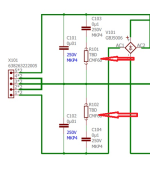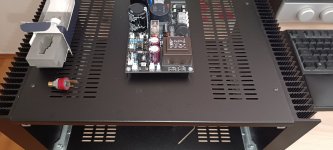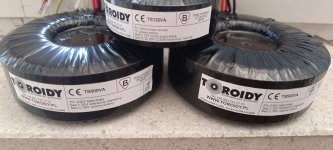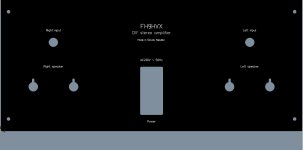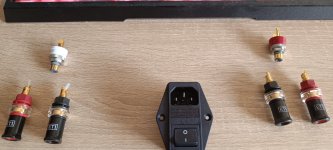I'm just wondering, could turn on order be an issue, ie, signal source is on before the amp, and this there is input before the amp has had a few seconds to warm up?
That's all I can think of that I may have done differently.
Cheers
That's all I can think of that I may have done differently.
Cheers
Hi Again.
On a side note, is it better to mount the bd139 on one of the FETs or on the heatsink in between the fets? Which FEt if so?
I'm thinking of remaking my chassis with larger Heatsinks..
Cheers
On a side note, is it better to mount the bd139 on one of the FETs or on the heatsink in between the fets? Which FEt if so?
I'm thinking of remaking my chassis with larger Heatsinks..
Cheers
Power amp should always be the last component turned on and first unit turned off.I'm just wondering, could turn on order be an issue, ie, signal source is on before the amp, and this there is input before the amp has had a few seconds to warm up?
That's all I can think of that I may have done differently.
Cheers
Post some clear detailed pics of your build to help troubleshoot.
Friends, after reading the whole thread I decided to build this amp. I ordered pcb from etsy.com, in dual mono configuration.
I'm just ordering parts from digikey & mouser and thinking about the FQA46N15+IXTH48P20P output pair 🙂
I'm just ordering parts from digikey & mouser and thinking about the FQA46N15+IXTH48P20P output pair 🙂
R101/R102 values are measured using the specific transformer for the build with the Quasimodo Jig and oscilloscope. If this cannot be done, just omit snubber components.
Find the three transformers in the vast table of Quasimodo Results (ONLY), which resemble your transformer most closely. Similar weight, similar physical size, similar VA rating, exact same construction method (EI / Toroidal / RCore / FlatPack / Talema sealed). Take the geometric mean of their Rsnub values. Done! You'll get a pretty good amount of resonance damping, which is immensely preferable compared to no damping at all.
Geometric mean of three numbers A, B, C = (A * B * C)^(1/3) . . . . . the cube root of the product of A, B, and C.
Geometric mean of three numbers A, B, C = (A * B * C)^(1/3) . . . . . the cube root of the product of A, B, and C.
I found a toroid similar to mine

My toroid parameters:
Torroidy 500VA, 230V primary, dual 35V seccondarries. Now I don't know if I can use an approximate RS value, or if the transformer power also plays a role.
As I live close to a transformer station the mains voltage is 237V AC. That's why I ordered transformers for 35V, at the output I will have approximately 39.5V AC. After rectifying the voltage, I get somewhere in the range of 52 - 53V DC with a sufficiently hard source 4x12.000uF/63V - per channel.
My toroid parameters:
Torroidy 500VA, 230V primary, dual 35V seccondarries. Now I don't know if I can use an approximate RS value, or if the transformer power also plays a role.
As I live close to a transformer station the mains voltage is 237V AC. That's why I ordered transformers for 35V, at the output I will have approximately 39.5V AC. After rectifying the voltage, I get somewhere in the range of 52 - 53V DC with a sufficiently hard source 4x12.000uF/63V - per channel.
Last edited:
@alain98
Google is your friend. Post 1407 is an annotated diagram/picture, no links.
Here you go:
https://hifisonix.com/projects/hifisonix-micro-ripple-eater/
Best,
Anand.
Google is your friend. Post 1407 is an annotated diagram/picture, no links.
Here you go:
https://hifisonix.com/projects/hifisonix-micro-ripple-eater/
Best,
Anand.
Last edited:
Friends, I would still be interested in the following parameters:
a, slew rate
b, power output into 4ohm (52 DC)
c, behaviour up to a complex load of 4.7 ohm + 470nf (in parallel).
Thank You!
a, slew rate
b, power output into 4ohm (52 DC)
c, behaviour up to a complex load of 4.7 ohm + 470nf (in parallel).
Thank You!
I have an answer for part b. It’s 153 watts/4 ohms. Hard clipping at 173 watts. If you desire more power, you should consider lower dc voltage rails and larger VA for your toroid. That way you will have more current available for 4 ohm loads.
For parts a, and c, you may have to measure yourself, unless someone else has measured the slew rate and behavior into the complex load you want (ie 4.7 ohms & 470nf).
You can see my measurements on page 70. My loudspeaker load isn’t complex, it’s simple.
Best,
Anand.
For parts a, and c, you may have to measure yourself, unless someone else has measured the slew rate and behavior into the complex load you want (ie 4.7 ohms & 470nf).
You can see my measurements on page 70. My loudspeaker load isn’t complex, it’s simple.
Best,
Anand.
I think 150W is fully sufficient, for most of us, ...
With more powerful 400-500VA transformers per channel, it would go even further, at least I think 🙂
With more powerful 400-500VA transformers per channel, it would go even further, at least I think 🙂
The toroids arrived today, the smaller one for Nelson Pass HPA-1. I am waiting for subpanel for 4U modushop box and L bracket for toroids. When the pcb for the power supply and the FH9HVX arrive, I'm working on the design of the front and back panel, which will be engraved.
Attachments
- Home
- Group Buys
- FH9HVX - Budget Conscious 100w Class AB for Lean Times
